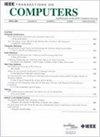Mix-GEMM: Extending RISC-V CPUs for Energy-Efficient Mixed-Precision DNN Inference Using Binary Segmentation
IF 3.6
2区 计算机科学
Q2 COMPUTER SCIENCE, HARDWARE & ARCHITECTURE
引用次数: 0
Abstract
Efficiently computing Deep Neural Networks (DNNs) has become a primary challenge in today's computers, especially on devices targeting mobile or edge applications. Recent progress on Post-Training Quantization (PTQ) and Quantization-Aware Training (QAT) has shown that the key to high energy efficiency lies in executing deep learning models with low- (8- to 5-bit) or ultra-low-precision (4- to 2-bit). Unfortunately, current Central Processing Unit (CPU) architectures and Instruction Set Architectures (ISAs) present severe limitations on the range of data sizes supported to compute DNN kernels. In this work, we present Mix-GEMM, a hardware-software co-designed architecture that enables RISC-V processors to efficiently compute arbitrary mixed-precision DNN kernels, supporting all data size combinations from 8- to 2-bit. By applying binary segmentation, our architecture can scale its throughput by decreasing the data size of the operands, resulting in a flexible approach capable of leveraging state-of-the-art QAT and PTQ to achieve high energy efficiency at a very low cost. Evaluating our Mix-GEMM architecture in a dual-issue in-order RISC-V processor shows that we are able to boost its performance and energy efficiency by up to求助全文
约1分钟内获得全文
求助全文
来源期刊

IEEE Transactions on Computers
工程技术-工程:电子与电气
CiteScore
6.60
自引率
5.40%
发文量
199
审稿时长
6.0 months
期刊介绍:
The IEEE Transactions on Computers is a monthly publication with a wide distribution to researchers, developers, technical managers, and educators in the computer field. It publishes papers on research in areas of current interest to the readers. These areas include, but are not limited to, the following: a) computer organizations and architectures; b) operating systems, software systems, and communication protocols; c) real-time systems and embedded systems; d) digital devices, computer components, and interconnection networks; e) specification, design, prototyping, and testing methods and tools; f) performance, fault tolerance, reliability, security, and testability; g) case studies and experimental and theoretical evaluations; and h) new and important applications and trends.
 求助内容:
求助内容: 应助结果提醒方式:
应助结果提醒方式:


